Introduction to Maven Interview Questions and Answers
Maven is a DevOps solution that minimizes the time and effort required for the build process. The tool assists businesses in raising their development standards while simultaneously reducing development time.
Maven is a build automation tool that is most commonly used in Java projects. However, Maven may also be used to generate and manage projects written in plenty of other languages like C#, Ruby, Scala, and others. The Maven project, which was originally part of the Jakarta Project, is now hosted by the Apache Software Foundation. According to Snyk’s JVM Ecosystem research, Apache Maven has a 64% market share among JVM build tools.
As we all know, Maven is a hugely popular tool, and it is clear that it has a lot of employment potential. If you want to land a DevOps job, this ‘Maven Interview Questions article is for you. This post will delve deep into assisting you to get knowledge about a variety of topics while also acing the interview.
Maven Interview Questions For Freshers
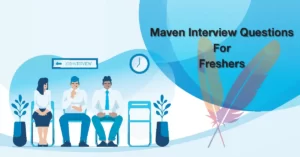
What do you mean by Maven?
Maven is an Apache Software Foundation-introduced project management tool that offers a comprehensive framework for the build cycle. It is open-source and is mostly used for Java-based projects. Maven is powered by a project object model, widely known as POM. It serves as the central repository for all dependencies. It adheres to the same folder structure across businesses and is readily linked with continuous integration technologies such as Jenkins.
Furthermore, it is in charge of the project’s reporting and documentation. It is implemented in the Java language. The interviewer can ask you these Maven interview questions to test your knowledge of Maven basics.
What are the key characteristics of Maven?
Maven’s key characteristics include the following:
|
Simple to use |
Maven provides simple project configurations based on best practices. |
|
Rapid |
In Maven, you might get a new project or module that was started in less than a second. |
|
Easy to learn |
Maven use and commands are rather simple to understand across all projects. As a result, the ramp-up period for new developers joining a project is quite short. |
|
Dependency management |
Maven offers enhanced dependency management, including automated updates and transitive dependencies. |
|
Numerous Projects |
Using Maven, you may simply work on multiple projects at the same time. |
|
Huge Library |
Maven offers a big and increasing collection of libraries and metadata that may be used right now. |
The interviewer can ask you these Maven interview questions to test your knowledge of the key characteristics of Maven. It is also among the frequently asked maven interview questions for DevOps.
Why should a project manager use Maven?
Maven performs an excellent job of rapidly establishing the project and does not contain complicated build files such as build.xml. Maven automatically downloads and stores your Java project’s dependencies in a local repository, where they can be accessed quickly as needed. Maven also contributes to keeping the deployment file short and easy to deploy by combining all of the jars into a bundle and storing them in the local repository. The interviewer can ask you these Maven interview questions to test your basic understanding.
What exactly is the Maven Architecture?
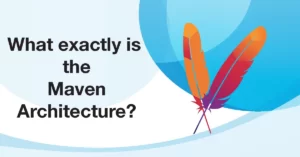
Maven projects are made up of a POM file that outlines every part of the project’s requirements. POM details aid in the selection of actions and the creation of artifacts. The pom.xml file is read as the first step in the Maven architecture. Maven then gets the dependencies defined in pom.xml from the central repository and stores them in the local repository. When a user first starts working in Maven, it gives a number of default options.
Following that, it generates a report based on the specifications. The interviewer can ask you these Maven interview questions to test your knowledge of Maven architecture. It is also among the frequently asked maven interview questions for DevOps. The graphic below depicts the build infrastructure for Maven projects.
When should Maven be used?
The Maven Build Tool is useful in the following situations:
- When there are a lot of dependencies in the project. Then, using Maven, you can manage those dependencies effortlessly.
- When a dependency’s version changes often. Simply edit the version ID in the pom file to update dependencies.
- Maven simplifies the management of continuous builds, integration, and testing.
- This is the program you use when you need to produce documentation quickly from source code. It is useful for compiling source code and packaging it into JAR or ZIP files.
The interviewer can ask you these Maven interview questions to test your knowledge of Maven uses.
What does Maven assist with?
Maven assists with the following tasks:
- Apache Maven aids with the administration of all project management operations such as building, documenting, releasing, and distribution.
- The tool streamlines the project creation procedure.
- It improves the project’s and the construction process’s performance.
- The download of JAR files and other dependencies is handled automatically.
- Maven makes it simple to find all of the necessary information.
- Maven enables developers to create projects in a variety of contexts without having to worry about dependencies, procedures, and so on.
- Adding new dependencies with Maven is straightforward; all you need to do is write the dependent code in the pom file.
The interviewer can ask you these advanced Maven interview questions to test your understanding of Maven assist. It is also among the frequently asked maven interview questions for selenium testers.
What are the aspects that Maven manages?
Maven handles the following developer activities:
- Build
- Documentation
- Reporting
- Dependencies
- SCMs
- Releases
- Distribution
- Mailing list
The interviewer can ask you these Maven interview questions to test your knowledge of Maven aspects. It is also among the frequently asked maven interview questions for DevOps.
Discuss Maven’s Fundamental Concepts
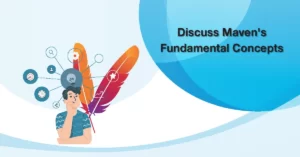
Maven’s fundamental concepts are as follows:
- POM Files:
Project Object Model (POM) files are XML files that incorporate project metadata and configuration information that Maven uses to build the project, including dependencies, source directory, plugin, goals, and so forth. When you wish to perform a maven command, you provide it with a POM file to work with. Maven reads the pom.xml file to complete its setup and functionality.
- Dependencies and Repositories:
Repositor
ies are directories that contain packaged JAR files, whereas dependencies are external Java libraries that Project requires. The local repository is merely a folder on the hard disc of your computer. If dependencies aren’t located in the local Maven repository, Maven fetches them from a central Maven repository and stores them in your local repository.
- Build Life Cycles, Stages, and Goals:
A build life cycle consists of a number of build phases, each with its own set of goals. A Maven command is a description of a build lifecycle, phase, or goal. When the maven command is used to execute a lifecycle, all of the build stages in that life cycle are also run. When a build phase is asked to be executed, it is initiated by all subsequent build phases in the specified sequence.
- Build Profiles:
Build Profiles are a set of configuration options that allow you to build your project in a number of ways. For example, you may need to build and test the project on the local computer. You may add alternative build profiles to the POM files using its profile elements to implement multiple builds that can be triggered in a number of ways.
- Build Plugins:
Build Plugins are employed to complete a certain task. A plugin may be included in the POM file. Maven comes with a number of pre-installed plugins, but you may also develop your own in Java. The interviewer can ask you these Maven interview questions to evaluate your understanding of Maven’s fundamentals. It is also among the frequently asked maven interview questions for selenium testers.
What exactly does the build tool do?
- Produces source code (if the auto-generated code is used)
- Documentation is generated from the source code.
- Source code compilation
- Compiles code and saves it as a JAR or ZIP file.
- Installs the packaged code in the local, server, or central repository.
The interviewer can ask you these advanced Maven interview questions to test your knowledge of the build tool. It is also among the most asked maven interview questions for testers.
What are the procedures for installing Maven for Windows?
Maven may be installed on a variety of platforms, including Windows, Linux, and Mac. The following are the procedures for installing Maven on Windows:
- Download and extract the Maven installation file.
- Add the environment variables Java_Home and Maven_Home.
- Add the environment path to the Maven variable.
- Examine the software’s version and ensure its legitimacy.
The interviewer can ask you these Maven interview questions to test your knowledge of Maven specifications.
Maven Interview Questions Intermediate Level
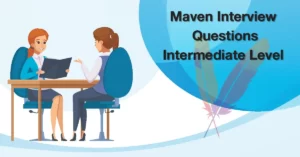
What exactly is POM?
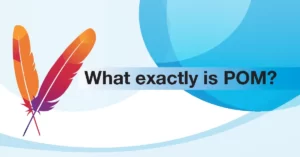
The Project Object Model (POM) refers to the XML files that include all of the project and configuration details. It contains a project description, as well as information about versioning and configuration management. The XML file may be found in the project’s home directory.
When we run a task, Maven looks for the POM in the current directory. The interviewer can ask you these Maven interview questions to evaluate your understanding of POM. It is also among the frequently asked maven interview questions for DevOps.
What exactly is a Maven artifact?
An artifact is typically a Jar file that is deployed to a repository The build function generates artifacts such as source Jar and compiled Jar. Every deployed artifact has an artifact ID, a group ID, and also a version string. These three parameters are used in Maven to identify artifacts. The Maven artifact is demonstrated in the code sample below.
- org.selenium
- seleniumJava
The interviewer can ask you these Maven interview questions to evaluate your understanding of the Maven artifact. It is also among the frequently asked maven interview questions for selenium testers.
What exactly is contained in the POM?
The following configurations are included in POM:
- Dependencies
- Developers and contributors
- Plugins
- Plugin configuration
- Resources
The interviewer can ask you these Maven interview questions to evaluate your understanding of POM. It is also among the most asked maven interview questions for testers.
Describe the different types of Maven Repositories.
Maven repositories are classified into three kinds:
|
Local Repository |
Central Repository |
Remote Repository |
|
This is stored on our local system in the .m2 directory. This is created when we successfully execute a Maven command. This contains all of the project’s dependencies. Maven initially explores the local repository for dependencies after scanning the pom file. |
Apache Maven provides the Central Repository. It includes the vast majority of commonly used libraries. Maven connects to a central repository if any of the dependencies may not be found in the local repository. |
Some businesses create their own custom repository for their project artifacts, jars, and libraries. This is a repository that is only accessible within that organization. |
The interviewer can ask you these Maven interview questions to evaluate your understanding of Maven Repositories.
Explain the dependency scope in Maven?
Maven’s dependency scopes are as follows:
|
Compile |
This is the default scope, and it displays which dependencies are accessible in the project’s classpath. |
|
Provided |
It denotes that the dependency is provided at runtime by the JDK, web server, or container. |
|
Runtime |
This indicates that the dependency is necessary during execution but not during compilation. |
|
Test |
It specifies that dependency is only available during the test compilation and execution phases. |
|
System |
IIt implies that the system path must be specified. |
|
Import |
This specifies that the dependencies in the identified or specified POM must be replaced with the dependencies in that POM’s section. |
The interviewer can ask you these advanced Maven interview questions to evaluate your understanding of dependency scope.
What exactly are the minimum needed elements for POM?
The minimum needed elements for POM are:
- project root
- modelVersion – should be 4.0.0
- groupId – project’s group id
- artifactId – artifact (project) id
- version – version of the artifact
The interviewer can ask you these Maven interview questions to evaluate your understanding of elements for POM. It is also among the frequently asked maven interview questions for selenium testers.
How does Maven function?
Maven operates in three stages:
- Read pom.xml file.
- The dependencies listed in pom.xml are then downloaded from the central repository and placed in the local repository.
- Finally, based on the requirements, it constructs and provides a report, along with managing life cycles, phases, goals, plugins, and certain other activities.
The interviewer can ask you these Maven interview qu
estions to test your knowledge of the Maven function. It is also among the most asked maven interview questions for testers.
What exactly do you mean by the Maven Archetype?
A Maven archetype is essentially a plugin tasked with constructing the project structure based on a certain skeleton or template. To make a project template, use the following command:
archetype mvn: generate
The interviewer can ask you these advanced Maven interview questions to test your knowledge of the Maven archetype.
What exactly do you mean by the phrase, Maven favors convention over configuration?
- In the case of Configuration, developers must manually define the build processes and specify each and every configuration in detail. Maven, on the other hand, follows a convention that eliminates the need for developers to manually define build processes.
- Furthermore, users are not required to specify the configuration in full for the sake of convention. When a developer creates a Maven project, Maven will automatically generate a structure. Developers only need to arrange the files correctly. There is no need to provide any configuration information in the pom.xml file.
The interviewer can ask you these Maven interview questions to test your in-depth understanding of Maven.
In Maven, what does it mean by Clean, Default, and Site?
The 3 built-in build life cycles are:
|
Clean |
The clean lifecycle is tasked with project cleaning. |
|
Default |
The project deployment is managed by the default lifecycle. |
|
Site |
The generation of the project’s site documentation is defined as the site lifecycle. |
The interviewer can ask you these Maven interview questions to test your knowledge of clean, default, and site.
What exactly are the various phases of a clean Lifecycle?
Phases of a clean Lifecycle are:
- pre-clean
- clean
- post-clean
The interviewer can ask you these Maven interview questions to test your knowledge of phases of the clean lifecycle.
What are the distinctions between a maven package and a maven install?
The maven package is in charge of transforming the compiled code into a distributable format. Maven install, on the other hand, adds the package to the local repository. It may be used in other projects as a dependency. The interviewer can ask you these advanced Maven interview questions to test your knowledge of the maven package and maven install. It is also among the most asked maven interview questions for testers.
What are the Several Stages of the Default Life Cycle?
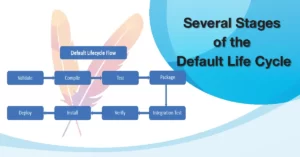
Phases of the default lifecycle:
|
Validate |
Validate involves ensuring that the project is proper and that you have all of the required information. |
|
Test |
Run the compiled source code via a unit testing framework. These tests do not require the code to be packed or deployed. Rather, take the compiled code and package it in a distributable format, like a JAR. |
|
Compile |
Compile the source code of the project. |
|
Verify |
Perform any required checks on the results of the integration tests to ensure that the quality standards are satisfied. |
|
Install |
Installs the package within the local repository, allowing it to be used as a dependency in other projects. |
The interviewer can ask you these advanced Maven interview questions to assess your understanding of the default life cycle.
In Maven, what is termed as SNAPSHOT?
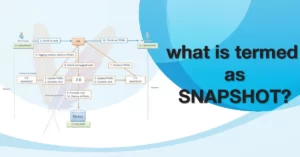
Maven snapshot refers to an unreleased version of Maven. There is a 1.0-SNAPSHOT version available before the first release. This version will eventually become the 1.0 version. It is known as the current development copy. Maven searches the remote repository for the new SNAPSHOT version. The interviewer can ask you these Maven interview questions to assess your understanding of the snapshot.
In Maven terminology, what is the ‘Goal’?
The term goal relates to a specific task that allows the project to be created and arranged. The order in which the intended goals are to be achieved is defined by phases that are stages in the life cycle. The interviewer can ask you these Maven interview questions to assess your understanding of Maven Goal.
What kinds of projects are there in Maven?
Maven provides templates for thousands of Java projects. This benefits the user because they no longer need to recall all configurations to set up a certain project. For instance, Spring Project, Spring MVC, Spring Boot, and so forth. The interviewer can ask you these Maven interview questions to assess your understanding of projects within maven.
What are the many kinds of Maven Plugins?
The following are the many types of Maven plugins:
- Building Plugins: These plugins are utilized during the build and are specified in the pom file’s building element.
- Reporting Plugins: These plugins are utilized during site creation and are declared in the pom file’s reporting element.
The interviewer can ask you these Maven interview questions to assess your understanding of maven plugins.
What would the “jar: jar” aim accomplish?
jar: jar does not recompile sources; it just creates a JAR from the target/classes directory after everything else has been done.
List the distinct sorts of Maven Build profiles.
The following are the several types of Maven Build profiles:
- Per-User: It’s described in Maven settings.xml file.
- Per Project: This is stated in the project’s pom.xml file.
- Global: This is explained in the global Maven settings.xml file.
How can you find out what version of mvn you’re using?
-mvn -version is the command to use.
What’s the distinction between Maven and Ant?
IMAGE NEW (Difference between Maven and Ant)
The following are the distinctions between Maven and Ant:
|
Maven |
Ant |
|
Maven is a build automation tool built on the notion of POM (Project Object Model). |
Ant is a Java library but also a command-line tool for compiling programs and fetching dependencies. |
|
It primarily serves as a software project management tool. |
It is primarily a building tool. |
|
Maven is declarative. The pom.xml file defines everything. |
Ant is procedural. All instructions on what to do and when to perform them are supplied in code. |
|
Maven follows a lifecycle. |
The lifecycle of an ant is non-existent. |
|
It is a framework. |
It is a toolbox. |
|
Maven includes reusable plugins. |
Ant scripts cannot be reused. |
|
Complex and less adaptable. |
Simpler and more adaptable. |
The interviewer can ask you these Maven interview questions to assess your understanding of the difference between Maven and Ant.
What is the purpose of Maven plugins? What ar
e the different sorts of Maven plugins?
Maven plugins are used for the following purposes:
- Making JAR files.
- Making WAR files.
- The source code files are being compiled.
- The code is being tested at the unit level.
- Making project documentation.
- Producing project reports
Maven plugins are classified into two types:
- Build plugins: These plugins are utilized during the build process and are set in the section of the pom.xml file.
- Reporting plugins: These plugins are set in the section of the pom.xml and executed during stage creation.
What does the term ‘Maven Clean’ imply?
Maven clean, as the name implies, is a plugin that attempts to clean the files and directories created by Maven during the build process. The plugin deletes the target folder, which contains all of the class files, documentation, and JAR files. The interviewer can ask you these Maven interview questions to assess your understanding of Maven Clean.
Maven Interview Questions Advanced Level

What is the purpose of an Optional Dependency?
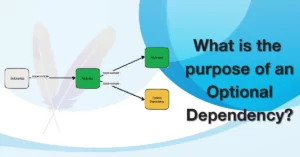
To reduce the transitive burden of some libraries, optional dependencies are used. When it is not possible to separate a project into sub-modules, these dependencies are employed. Some dependencies are only used for a single feature in the project, and if that feature is not present, the dependency will be ignored. The interviewer can ask you these Maven interview questions to examine your knowledge of optional dependency.
What exactly is a ‘Dependency Scope,’ and how many different types of Dependency Scopes are there?
The term “dependency scope” refers to all dependencies associated with the current stage of the build.
Given below are the different sorts of dependency scopes:
- Compile
- Provided
- Runtime
- Test
- System
- Import
The interviewer can ask you these Maven interview questions to examine your knowledge of dependency scope.
What is the purpose of an Optional Dependency?
To reduce the transitive burden of some libraries, optional dependencies are used. When it is not possible to separate a project into sub-modules, these dependencies are employed. Some dependencies are only used for a single feature in the project, and if that feature is not present, the dependency will be ignored. The interviewer can ask you these Maven interview questions to examine your knowledge of optional dependency.
What exactly is ‘Dependency Exclusion’?
The exclusion element is used to remove any transitive dependencies. If X is dependent on Y and Y is dependent on Z, then X can be marked as excluded from Z. Interviewer can ask you these Maven interview questions to examine your knowledge of dependency exclusion.
What exactly is the settings.xml file in Maven?
The Maven settings.xml file provides elements that define the values required to customize Maven execution. It is made up of the following configurations:
- Configuration of a proxy
- Configuration of the local repository
- Configuration of a remote repository
- Configuration of the central repository
The interviewer can ask you these Maven interview questions to examine your knowledge of setting.xml.
What exactly does the word ‘Super POM’ mean?
Maven’s default POM is referred to as Super POM. Maven POMs can be inherited from a parent or generated by default. Effective POM is utilized to carry out any specific aims. Super POM enables developers to configure the pom.xml file with the fewest configurations possible. The interviewer can ask you these Maven interview questions to examine your knowledge of Super POM.
Conclusion to Maven Interview Questions
Many businesses rely on this tool and seek Maven-skilled professionals to improve their development standards. A solid understanding of the Apache Maven tool can open doors to exciting new prospects. We are certain that most of your concerns about Maven interview questions have been addressed. We looked at a wide range of Maven interview questions that are frequently asked in interviews.
You will be able to understand them easily if you practice and learn well. You can also check out our other blogs.
jQuery(document).ready(function($) {
var delay = 100; setTimeout(function() {
$(‘.elementor-tab-title’).removeClass(‘elementor-active’);
$(‘.elementor-tab-content’).css(‘display’, ‘none’); }, delay);
});
Frequently Asked Questions
Maven is developed in Java and is used to build projects written in C#, Scala, Ruby, and other programming languages. This tool, which is based on the Project Object Model (POM), has improved the lives of Java developers and made it easier when developing reports, checking builds, and testing automation setups. Maven emphasizes the simplification and uniformity of the building project, ensuring the following:
- Builds
- Documentation
- Dependencies
- Reports
- SCMs
- Distribution
- Releases
- Mailing list
Let’s move on to the next faq for Maven Interview Questions blog.
Maven is a widely used open source build solution for enterprise Java projects that is designed to automate most of the development process. Rather than the task-based method used in Ant or traditional build files, Maven employs a declarative approach in which the project structure and contents are defined. This helps to enforce company-wide development standards while also reducing the time required to write and maintain build scripts. Let’s move on to the next faq for Maven Interview Questions blog.
Let’s have a look at some popular and essential maven commands.
|
mvn clean |
This command removes the target directory from the maven project. |
|
mvn compiler:compile |
The maven project’s java source classes are compiled with this command. |
|
mvn compiler:testCompile |
This command compiles the maven project’s test classes. |
|
mvn package |
This command builds the maven project and packages it as a JAR, WAR, or other format. |
|
mvn install |
This command builds the maven project and adds the project files (JAR, WAR, pom.xml, and so on) to the local repository. |
Let’s move on to the next faq for Maven Interview Questions blog.
- clean: clean up following the build.
- compiler: compiles java source code.
- deploy: deploys the artifact for the remote repository.
- failsafe: operates the JUnit integration examinations within an isolated classloader.
- install: It installs the built artifact within a local repository.
- resources: duplicates the resources to the output directory for incorporating in the JAR.
- site: creates a site for the present project.
- surefire: operates the JUnit unit assessments within an isolated classloader.
- verifier: verifies the presence of specific conditions. It’s helpful for integration assessments.
Let’s move on to the next faq for Maven Interview Questions blog.
Maven is a project management and comprehension tool that offers developers a full build lifecycle framework. Because Maven utilizes a standard directory layout together with a default build lifecycle, the development team can quickly automate the project’s build infrastructure.
In the case of multiple development teams, Maven can quickly set up the way to work according to standards. Because most project setups are straightforward and reusable, Maven simplifies the developer’s life when creating reports, checks, building, and testing automation setups. Let’s move on to the next faq for Maven Interview Questions blog.
You can build a Maven project from the command line by using the mvn command. The command must be run in the same directory as the relevant pom file. This command accepts as parameters the build life cycle, phase, or goal.
Maven reads the pom file and settles the project’s dependencies. Maven checks to see if the dependencies are present in a local repository, and if they are, they are used.
Maven downloads the dependent artifacts from the central repository or the specified ones into the local repository if the dependency is not available in the build reactor or the local repo. Maven runs all life cycle phases until the specified one is reached. Let’s move on to the next faq for Maven Interview Questions blog.
In Maven, a profile is a different set of configuration values that set or override default values. You can customize a build for various environments by using a profile. Profiles are defined and assigned an identifier in the pom.xml file. Then, run Maven with a command-line flag instructing Maven to execute goals in a specified profile. Let’s move on to the next faq for Maven Interview Questions blog.
A Maven project’s source code is compiled using the compiler plugin. This plugin has two goals that are already tied to specific stages of the default lifecycle:
- compile: compile the primary source files
- test Compile: compile the source code for the tests.
The compiler plugin in the POM is as follows:
<plugin>
<artifactId>maven-compiler-plugin</artifactId>
<version>3.7.0</version>
<configuration>
…
</configuration>
</plugin>
Let’s move on to the next faq for Maven Interview Questions blog.
What is the difference between Maven and Gradle?
|
Criteria |
Maven |
Gradle |
|
Based on |
Maven is a platform for creating pure Java language-based software. |
Gradle is a platform for creating domain-specific language projects. |
|
Major Focus |
Creating applications within a specified time frame. |
Adding new features to existing applications to make them more useful. |
|
Java Compilation |
Compilation is required. |
It does not require compilation. |
|
Customization |
This tool only serves a small number of developers and is not very customizable. |
Because it supports a variety of IDEs, this tool is highly customizable. |
|
Supported Languages |
C#, Java, Scala, and Ruby. |
C++, Java, C, and Groovy. |
|
Configuration |
Extensible Markup Language(XML) |
Groovy-based Domain-specific language(DSL) |
|
Usability |
This tool is widely utilized among numerous users and it is easily accessible. |
It is a new tool that will take some time for users to get used to. |
It is also among the frequently asked gradle and maven interview questions. Interviewers can ask these gradle and maven interview questions to evaluate your in depth knowledge of the concept. So make sure to study distinct gradle and maven interview questions. Let’s move on to the next faq for Maven Interview Questions blog.
What is the difference between Maven and Jenkins?
|
Maven |
Jenkins |
|
Maven is a build tool that assists with build and version control. |
Jenkins is a free and open-source software tool for continuous integration. It was created for testing and reporting purposes. |
|
Maven was first introduced in early 2004. |
Jenkins debuted in 2011. |
|
Companies such as Zillow, Intuit, Zalando, and Yammer use Maven. |
Jenkins is being used by companies such as Netflix, Facebook, eBay, and LinkedIn. |
|
Maven is compatible with tools such as Buddy, Flyway, JitPack, SonarQube, and others. |
Jenkins is integrated with tools such as Slack, Datadog, BrowserStack, and others. |
It is also among jenkins interview questions. Interviewer can ask these maven and jenkins interview questions to evaluate your in depth knowledge of the concept. So make sure to study distinct maven and jenkins interview questions.













